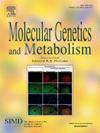Pegvaliase treatment normalizes blood neurotransmitter metabolites in adults with phenylketonuria
IF 3.7
2区 生物学
Q2 ENDOCRINOLOGY & METABOLISM
引用次数: 0
Abstract
Phenylketonuria (PKU) is caused by deficient activity of phenylalanine hydroxylase (PAH), the enzyme that converts phenylalanine (Phe) to tyrosine (Tyr), leading to a toxic accumulation of Phe and reduced Tyr in the blood and brain. Abnormal Phe and Tyr levels in the brain disrupt normal neurotransmitter biosynthesis and may contribute to the cognitive and psychiatric deficits observed in individuals with PKU. Blood neurotransmitter metabolites (NTMs) may serve as biomarkers that reflect neurotransmitter levels in the brain. In this study, blood NTMs correlated with brain NTMs and neurotransmitters in wild-type and PAH-deficient mice treated with PAH gene therapy. Pegvaliase is an enzyme substitution therapy that lowers blood Phe levels and is approved for individuals with PKU and uncontrolled blood Phe concentrations (>600 μmol/L) despite prior management. The current work evaluated the relationship between blood NTMs and blood Phe in pegvaliase-treated, Phase 3, PRISM-1 (NCT01819727) and PRISM-2 (NCT01889862) study participants (Pegvaliase Group; N = 109). At baseline, individuals in the Pegvaliase Group had lower levels of the NTMs homovanillic acid (HVA), 3-methoxy-4-hydroxyphenyl glycol (MOPEG), and 5-hydroxyindoleacetic acid (5HIAA), and higher levels of the NTM phenylacetylglutamine (PAG) than age- and sex-matched healthy controls. PAG levels correlated positively with Phe levels (r = 0.833; p < 0.001), while HVA, MOPEG, and 5HIAA levels correlated negatively with Phe levels (r = −0.588, −0.561, and −0.857, respectively; all p < 0.001) across all timepoints. In participants with longitudinal NTM measurements available at baseline, 12 months, and 24 months (Pegvaliase Subgroup; n = 91), blood NTM levels improved from baseline with pegvaliase treatment at 12 months and 24 months, and median levels were normalized with blood Phe level reductions below 360 μmol/L after 24 months of treatment with pegvaliase, including in participants with blood Phe <30 μmol/L. In conclusion, blood NTM levels correlated with blood Phe levels, and pegvaliase improved blood NTM levels in a large cohort of individuals with PKU.
Pegvaliase 治疗可使苯丙酮尿症成人患者的血液神经递质代谢物恢复正常。
苯丙酮尿症(PKU)是由苯丙氨酸羟化酶(PAH)活性不足引起的,这种酶能将苯丙氨酸(Phe)转化为酪氨酸(Tyr),从而导致血液和大脑中 Phe 的毒性积累和 Tyr 的减少。大脑中异常的 Phe 和 Tyr 水平会破坏正常的神经递质生物合成,并可能导致 PKU 患者出现认知和精神障碍。血液中的神经递质代谢物(NTMs)可作为反映大脑中神经递质水平的生物标志物。在这项研究中,接受 PAH 基因治疗的野生型小鼠和 PAH 缺失型小鼠血液中的 NTMs 与大脑中的 NTMs 和神经递质相关。Pegvaliase 是一种酶替代疗法,可降低血液中的 Phe 含量,已被批准用于治疗 PKU 患者,这些患者尽管之前接受过治疗,但血液中的 Phe 浓度仍无法控制(>600 μmol/L)。目前的研究评估了接受过Pegvaliase治疗的PRISM-1(NCT01819727)和PRISM-2(NCT01889862)3期研究参与者(Pegvaliase组;N = 109)的血液NTM与血液Phe之间的关系。基线时,与年龄和性别匹配的健康对照组相比,Pegvaliase 组的个体体内同香草酸 (HVA)、3-甲氧基-4-羟基苯基乙二醇 (MOPEG) 和 5-羟基吲哚乙酸 (5HIAA) 等非甲硝基物质的水平较低,而非甲硝基物质苯乙酰谷氨酰胺 (PAG) 的水平较高。PAG 水平与 Phe 水平呈正相关(r = 0.833; p
本文章由计算机程序翻译,如有差异,请以英文原文为准。
求助全文
约1分钟内获得全文
求助全文
来源期刊

Molecular genetics and metabolism
生物-生化与分子生物学
CiteScore
5.90
自引率
7.90%
发文量
621
审稿时长
34 days
期刊介绍:
Molecular Genetics and Metabolism contributes to the understanding of the metabolic and molecular basis of disease. This peer reviewed journal publishes articles describing investigations that use the tools of biochemical genetics and molecular genetics for studies of normal and disease states in humans and animal models.
 求助内容:
求助内容: 应助结果提醒方式:
应助结果提醒方式:


